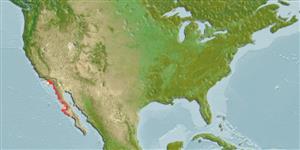Teleostei (teleosts) >
Eupercaria/misc (Various families in series Eupercaria) >
Sciaenidae (Drums or croakers)
Etymology: Roncador: Spanish, roncar, roncador = snore, snort (1882) (Ref. 45335).
Eponymy: Robert Edwards Carter Stearns (1827–1909) was an American conchologist who served as director of the museum of the California Academy of Sciences. [...] (Ref. 128868), visit book page.
More on author: Steindachner.
Environment: milieu / climate zone / depth range / distribution range
Ecology
Marine; demersal; depth range 1 - 22 m (Ref. 96339). Subtropical; 42°N - 22°N, 125°W - 106°W
Eastern Pacific: Point Conception in California, USA to southern Baja California, Mexico.
Size / Weight / Age
Maturity: Lm ? range ? - ? cm
Max length : 70.0 cm TL male/unsexed; (Ref. 9118); common length : 30.0 cm TL male/unsexed; (Ref. 9118); max. published weight: 4.8 kg (Ref. 2850); max. reported age: 15 years (Ref. 56049)
Occur in sandy shores and bays, mostly in shallow surf zones, but also to 15 m depth. Often found near rocks and entrances to bays. Usually form small groups, but aggregate for spawning. Pelagic spawners (Ref. 56049). Feed on invertebrates, such as marine worms, clams, crabs and small crustaceans.
Life cycle and mating behavior
Maturity | Reproduction | Spawning | Eggs | Fecundity | Larvae
Pelagic spawner (Ref. 56049).
Eschmeyer, W.N., E.S. Herald and H. Hammann, 1983. A field guide to Pacific coast fishes of North America. Boston (MA, USA): Houghton Mifflin Company. xii+336 p. (Ref. 2850)
IUCN Red List Status (Ref. 130435: Version 2024-1)
Threat to humans
Harmless
Human uses
Fisheries: commercial; gamefish: yes
Tools
Can't connect to MySQL database fbquizv2. Errorcode: Too many connections
